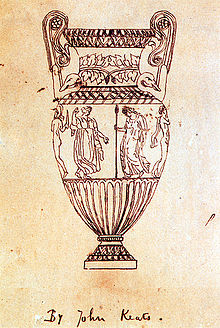
Back قصيدة على جرة إغريقية Arabic Ode auf eine griechische Urne German Oodi kreikkalaiselle uurnalle Finnish Ode sur une urne grecque French Ode su un'urna greca Italian 그리스 항아리에 대한 송시 Korean Ode on a Grecian Urn Latin ਓਡ ਆਨ ਅ ਗਰੇਸੀਅਨ ਅਰਨ Punjabi Oda na urnę grecką (wiersz Johna Keatsa) Polish Ода к греческой вазе Russian

"Ode on a Grecian Urn" is a poem written by the English Romantic poet John Keats in May 1819, first published anonymously in Annals of the Fine Arts for 1819[1] (see 1820 in poetry).
The poem is one of the "Great Odes of 1819", which also include "Ode on Indolence", "Ode on Melancholy", "Ode to a Nightingale", and "Ode to Psyche". Keats found existing forms in poetry unsatisfactory for his purpose, and in this collection he presented a new development of the ode form. He was inspired to write the poem after reading two articles by English artist and writer Benjamin Haydon. Through his awareness of other writings in this field and his first-hand acquaintance with the Elgin Marbles, Keats perceived the idealism and representation of Greek virtues in classical Greek art, and his poem draws upon these insights.
In five stanzas of ten lines each, the poet addresses an ancient Greek urn, describing and discoursing upon the images depicted on it. In particular he reflects upon two scenes, one in which a lover pursues his beloved, and another where villagers and a priest gather to perform a sacrifice. The poet concludes that the urn will say to future generations of mankind: "'Beauty is Truth, Truth Beauty.' – that is all / Ye know on earth, and all ye need to know". Critics have debated whether these lines adequately perfect the conception of the poem. Critics have also focused on the role of the speaker, the power of material objects to inspire, and the paradoxical interrelation between the worldly and the ideal reality in the poem.
"Ode on a Grecian Urn" was not well received by contemporary critics. It was only by the mid-19th century that it began to be praised, and it is now considered to be one of the greatest odes in the English language.[2] A long debate over the poem's final statement divided 20th-century critics, but most agreed on the beauty of the work, despite certain perceived inadequacies.
- ^ "Annals of the fine arts. v.4 1819". HathiTrust. Retrieved 31 August 2019.
- ^ Sheats 2001 p. 86